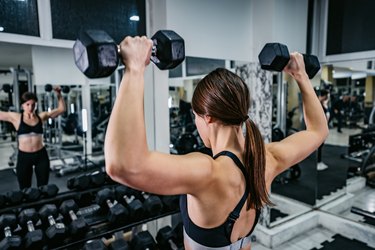
Sculpting your arms requires hard work and dedication. For anyone diligently calculating calories burned during arm exercises, you need to consider a number of factors, such as type of movement and intensity. More reps and sets with more weight typically leads to a greater caloric deficit.
Video of the Day
Video of the Day
Calories Burned During Arm Exercises
Every arm exercise, especially those involving cardio movements, will vary in how many calories you burn. The following are a few arm exercises and the total calories burned in 30 minutes. However, calorie counts always differ based on weight, intensity and gender.
In general, a 155-pound person will burn 112 calories in 30 minutes of weightlifting, which includes bicep and tricep curls. At a vigorous pace, the burn increases to 223 calories in half an hour, according to Harvard Health Publishing. A circuit training routine in which you cycle through several arm exercises can burn up to 288 calories per 30 minutes for a 155-pound person, per the University of Rochester Medical Center (UR).
Scared of dumbbells and barbells? You can perform arm movements using your own body as weight. For example, push-ups and planks don't use equipment, and instead use your body weight as resistance. The Mayo Clinic says this form of weight training is as effective as training with free weights or weight machines.
Increasing Calories Burned
You can burn more calories on arm workout day by adding more stress to the arms and keeping them fresh for weight training through the following actions:
- Skip the isolation exercises. In your workout routine, perform compound exercises that require movement of multiple muscle joints. Movements such as a push-up are considered compound because they work several muscle groups at the same time. According to the American Council on Exercise (ACE), compound exercises burn more calories and help the body increase its energy expenditure.
- Decrease
time between strength-training sets. According to ACE,
the most significant contributor to fat loss during resistance training is
resting less between sets, as this creates significant metabolic stress on the
body. The result is a hormonal response that enables your body to use fat and generate
muscle.
- Don't
do a steady-state arm lifting session. Instead, try adding a high-intensity interval training (HIIT) session a couple times a week. ACE says that the body burns 5 calories per liter of oxygen consumed. When performing short intervals of extremely high-intensity exercise that uses a lot of muscle mass, your body requires a greater amount of oxygen during both the exercise session and in the recovery period.
- Strength train before your cardio session. In an April 2015 study from the_ Journal of Strength and Conditioning Research_, researchers found that aerobic exercise before a strength training session impaired the strength performance, and people tended to perform fewer weightlifting repetitions after cardio. Moving strength to the beginning (after a warm-up) can keep your form in tact.
- Harvard Health Publishing: “Calories Burned In 30 minutes for People of Three Different Weights”
- Mayo Clinic: “Is Body Weight Training Effective As a Strength-Training Exercise?”
- American Council on Exercise: "5 Benefits of Compound Exercises"
- University of Rochester Medical Center: "Calorie Burn Rate Calculator"
- American Council on Exercise: "The BEST Resistance-training Program for Fat Loss"
- American Council on Exercise: "8 Reasons HIIT Workouts are So Effective"